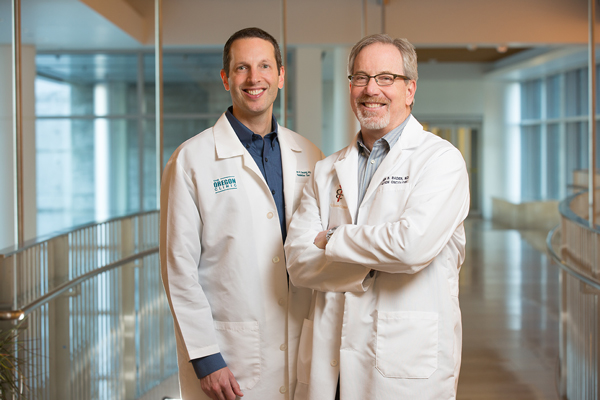
Prostate cancer is the most common cancer among American men with about one in seven men diagnosed during his lifetime. The Oregon Clinic Radiation Oncologists Dr. Eric Hansen and Dr. Stephen Bader are on the cutting edge of treating prostate cancer, offering a new treatment called high-dose rate (HDR) brachytherapy. They expanded their practice to include HDR brachytherapy because it can improve cure rates and reduce side effects compared to traditional treatments.
The Oregon Clinic’s Dr. Eric Hansen and Dr. Stephen Bader are excited about bringing this state-of-the-art treatment to patients. Dr. Hansen says, “We are very pleased to add HDR brachytherapy to our toolbox. This new technique offers us more flexibility in planning and in consistently achieving high-quality implants.”
Currently, a common prostate cancer treatment is low-dose rate (LDR) brachytherapy, which places permanent radioactive seeds in the prostate that release radiation for a few months. LDR brachytherapy can be an effective treatment, but is not without frustrations. Because of the radioactivity men treated with a traditional LDR implant must follow radiation safety precautions for about two to three months. Also, radioactive seeds can move from their intended position after the implant due to swelling and sometimes that can increase side effects.
New research shows that HDR brachytherapy is an effective alternative to LDR brachytherapy, with shorter, stronger, and more precise radiation treatment. During HDR brachytherapy, a single small radioactive source is temporarily implanted into the prostate under robotic control while the patient is under anesthesia. A computer is used to control the exact location and duration of the radiation to precisely target the prostate cancer. The procedure takes only about two to three hours and the radiation treatment itself is over in about ten minutes.
After treatment, there is no radioactivity left in the patient’s body so there is no risk of second-hand exposure to friends and family. Also, there is no risk of radioactive seed migration since the implant is temporary, not permanent as with
LDR brachytherapy.
Recent research studies suggest that men treated with high-dose rate brachytherapy may be able to eliminate or reduce their need for hormone therapy, which can improve quality of life for patients. Additionally, the new HDR technique allows physicians to treat men with more advanced prostate cancers who would not be eligible for a traditional LDR seed implant. Dr. Bader says, “Better quality implants with HDR means better outcomes for patients, including improved chance for cure and reduced risk of side effects.”
Introducing HDR prostate brachytherapy reflects the deep commitment of The Oregon Clinic and its providers to be on the forefront of evidence-based medicine offering our patients the most effective, least invasive treatments available. For more information about HDR brachytherapy at The Oregon Clinic, visit oregonclinic.com/hdr-brachytherapy.
Photo: Dr. Eric Hansen and Dr. Stephen Bader at The Oregon Clinic